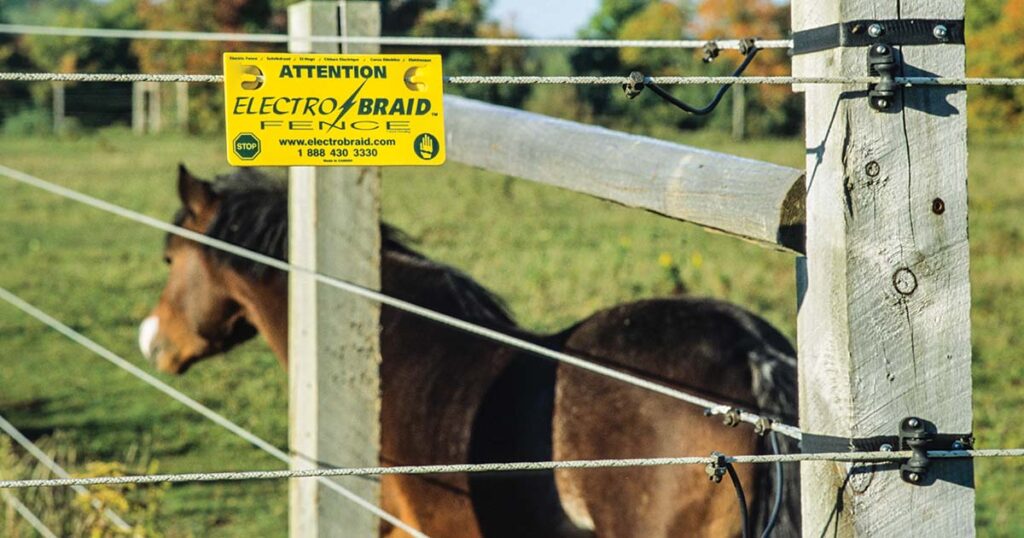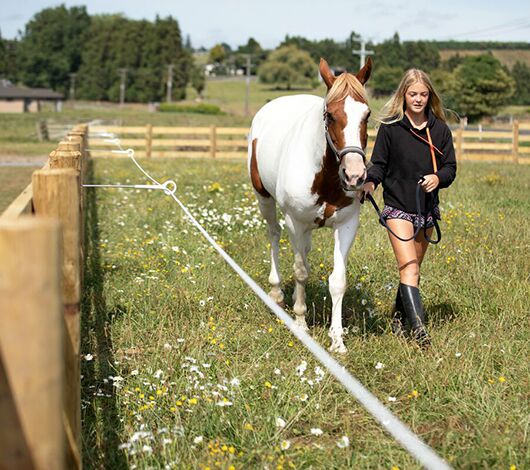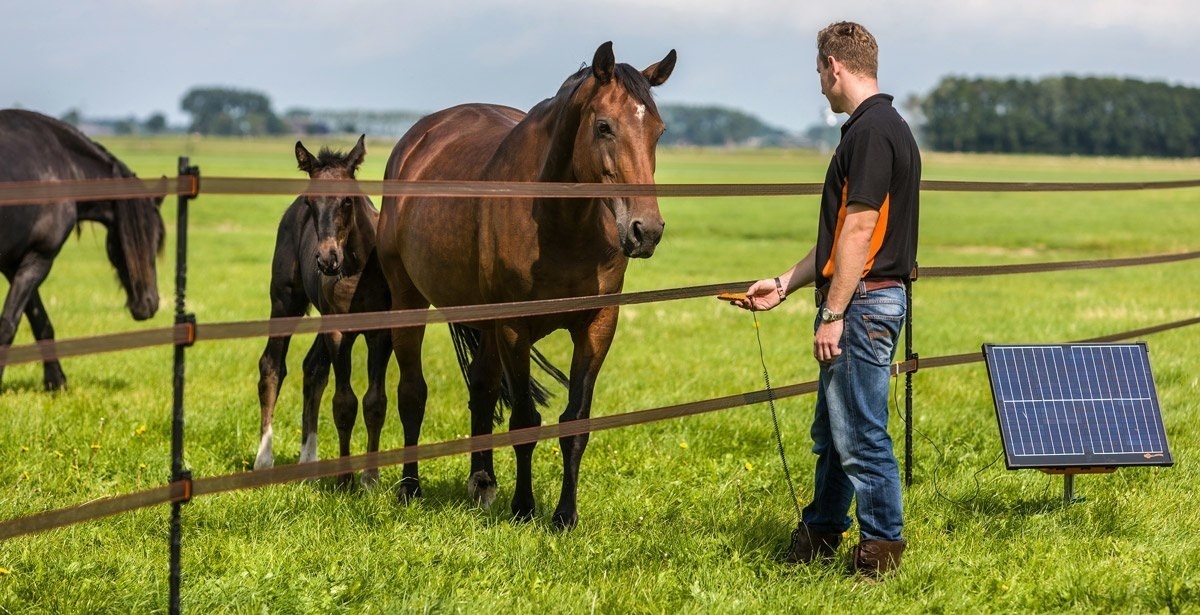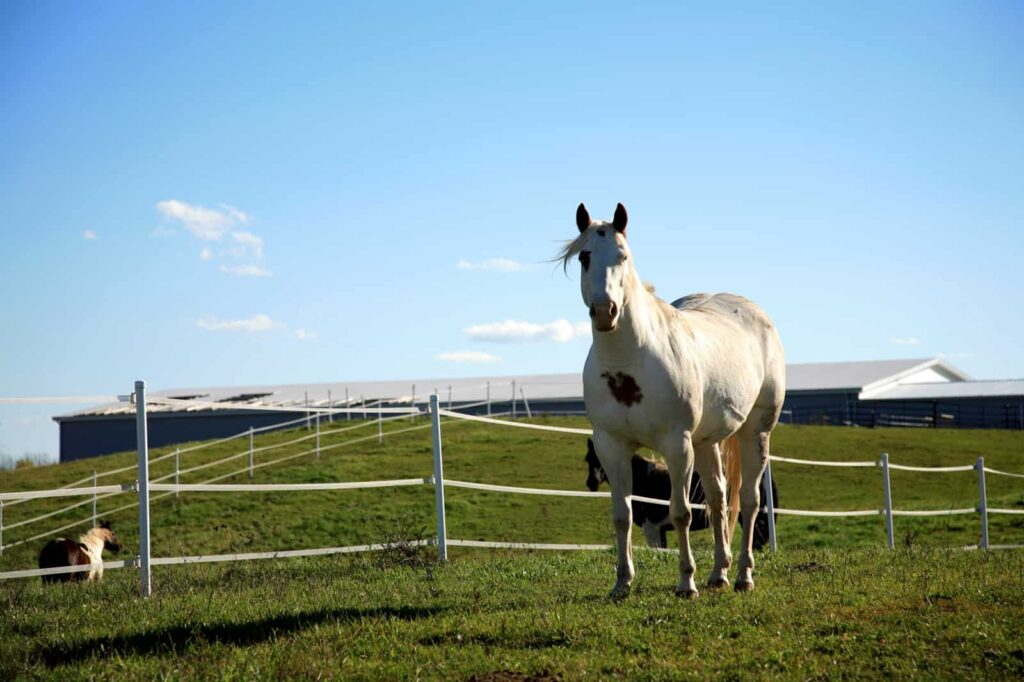Are you looking for reliable information on electric horse fencing? If so, you’ve come to the right place! In this article, we will dive into all aspects of electric horse fencing and provide you with valuable insights and answers to your questions. Whether you’re a horse owner or simply interested in learning more about fence options, this article will cover everything you need to know. So let’s get started and explore the world of electric horse fencing!
First and foremost, we’ll discuss what electric horse fencing is and how it works. We’ll uncover the benefits of using electric fencing for horses and the different types of electric fences available. From there, we’ll dive into the installation process and provide you with step-by-step instructions to ensure a secure and effective fence for your horses. Additionally, we’ll explore important factors to consider when choosing the right electric fence for your specific needs, including materials, height, and visibility.
Furthermore, we’ll address common concerns and questions that horse owners may have, such as the safety of electric fencing for horses, maintenance requirements, and troubleshooting tips. We’ll also provide tips on how to properly train your horses to respect the electric fence and avoid potential injuries. Finally, we’ll discuss the cost analysis of electric horse fencing and compare it to other fencing options, allowing you to make an informed decision that fits your budget and requirements.
Stay tuned for the full article on our website, where we will cover these topics and more in detail. You can trust that our information is reliable and well-researched, ensuring that you have access to accurate and expert advice. So, if you’re ready to learn all about electric horse fencing and become a fencing pro, make sure to check out our upcoming blog post!
All About Electric Horse Fencing
Electric horse fencing has become a popular choice among horse owners due to its effectiveness, cost-efficiency, and ease of installation. In this article, we will explore the different types of electric horse fencing, how to choose the right fence for your horses, the benefits of electric horse fencing, installation steps, proper maintenance and upkeep, training horses to electric fences, troubleshooting issues, preventing injuries, adding security features, environmental considerations, comparisons with traditional horse fencing, regulations and codes, and case studies of successful implementations. So let’s dive deep into the world of electric horse fencing!

Types of Electric Horse Fencing
High Tensile Wire
High tensile wire fencing is a popular choice for electric horse fences due to its strength and durability. It consists of multiple strands of tightly stretched wire, usually made of galvanized steel, which provides a secure barrier for horses. We will discuss the installation and possible drawbacks of high tensile wire fencing.
Polytape
Polytape horse fencing is an excellent choice for those who prioritize visibility. It consists of wide, flat, woven strands that are highly visible to horses, preventing them from running into the fence. We will explore the benefits, installation, and maintenance of polytape electric horse fences.
Polyrope
Polyrope horse fencing combines the durability of wire with the visibility of tape. It is made of woven strands of polyester and stainless steel, providing strength and visibility. We will discuss the features, pros, and cons of polyrope electric horse fences.
Electric Mesh
Electric mesh horse fencing is a versatile option that provides both containment and security. It consists of woven wires with built-in electrical strands, creating a barrier that is both flexible and effective. We will explore the unique features and installation process of electric mesh horse fencing.
ElectroBraid
ElectroBraid is a popular brand of electric horse fencing that utilizes a combination of high tensile wire and conductive polymer material. It offers the strength of wire and the safety of polymer, making it an ideal choice for horse owners. We will discuss the advantages and possible drawbacks of ElectroBraid electric horse fencing.
Choosing the Right Electric Horse Fence
When choosing an electric horse fence, several factors need to be considered to ensure the safety and well-being of your horses. In this section, we will discuss horse safety considerations, budget-friendly options, durability and maintenance aspects, and the difficulty of installation.
Considerations for Horse Safety
Ensuring the safety of your horses should be the primary concern when selecting an electric horse fence. We will discuss the importance of choosing a fence with appropriate visibility, height, and spacing to prevent injuries and escapes.
Budget-Friendly Options
Electric horse fencing can be a cost-effective solution compared to traditional horse fencing options. We will explore different budget-friendly options and their long-term benefits.
Durability and Maintenance
Investing in a durable and low-maintenance electric horse fence can save you time and money in the long run. We will discuss the importance of selecting materials that can withstand environmental factors and require minimal upkeep.
Installation Difficulty
The level of difficulty in installing an electric horse fence can vary depending on the type of fencing chosen. We will provide insights into the installation process and discuss potential challenges that may arise.

Benefits of Electric Horse Fencing
Electric horse fencing offers various advantages that make it a popular choice among horse owners. In this section, we will explore the safety and security benefits, cost-effectiveness, ease and speed of installation, and versatility of electric horse fencing.
Safety and Security
Electric horse fences act as a deterrent, preventing horses from leaning, pushing, or attempting to jump over the fence. We will discuss how electric horse fencing contributes to horse safety and security.
Cost-Effectiveness
Compared to traditional horse fencing options, electric horse fencing can be more cost-effective. We will explore the initial setup costs, long-term savings, and potential return on investment.
Easy and Quick Installation
Installing an electric horse fence is relatively straightforward and can be completed in a shorter timeframe compared to traditional fencing options. We will discuss the steps involved in the installation process and highlight the ease and speed of setting up an electric horse fence.
Versatility
Electric horse fencing can be used in various settings, such as large equestrian facilities, private horse properties, or as temporary fencing for pastures. We will explore the versatility of electric horse fencing and its applicability in different situations.
Proper Installation of Electric Horse Fencing
Proper installation of electric horse fencing is essential to ensure its effectiveness and long-term functionality. In this section, we will discuss the necessary materials, determining the fence line, installing fence posts, connecting and tensioning the wire, and the importance of insulators and chargers.
Getting the Right Materials
Choosing the right materials for your electric horse fence is crucial for its successful installation and functionality. We will discuss the necessary components and their specific purposes.
Determining the Fence Line
Mapping out the fence line accurately is crucial for the proper installation of an electric horse fence. We will provide guidance on how to determine the fence line and ensure it meets your requirements.
Installing Fence Posts
Proper installation of fence posts is imperative for the stability and effectiveness of an electric horse fence. We will discuss the different types of posts, spacing considerations, and the correct installation techniques.
Connecting and Tensioning the Wire
Properly connecting and tensioning the wire ensures that your electric horse fence functions optimally. We will guide you through the process and provide tips for achieving the desired tension.
Insulators and Chargers
Insulators and chargers are critical components of an electric horse fence. We will discuss their importance, the various types available, and how to choose the right ones for your specific needs.

Maintenance and Upkeep of Electric Horse Fences
Regular maintenance and upkeep of an electric horse fence are essential to maximize its lifespan and effectiveness. In this section, we will discuss the importance of regular inspections, reinforcing weak areas, checking and replacing insulators, maintaining grounding, and keeping vegetation clear.
Regular Inspections
Regular inspections help identify any issues or weaknesses in the electric horse fence. We will discuss the frequency of inspections and what to look for during these inspections.
Reinforcing Weak Areas
Identifying and reinforcing weak areas in an electric horse fence is crucial to prevent fence breaches or horse injuries. We will discuss common weak spots and provide strategies for reinforcing those areas.
Checking and Replacing Insulators
Insulators play a vital role in preventing electrical leakage and ensuring the proper functioning of an electric horse fence. We will discuss the importance of regularly checking and replacing insulators when needed.
Maintaining Grounding
Proper grounding is essential for the effectiveness of an electric horse fence system. We will discuss the significance of maintaining proper grounding and provide guidance on how to do so.
Keeping Vegetation Clear
Vegetation can interfere with the functionality of an electric horse fence by grounding the electrical current. We will discuss the importance of keeping vegetation clear and strategies for vegetation management.
Training Horses to Electric Fences
Properly training horses to respect and avoid electric fences is crucial for their safety and the fence’s effectiveness. In this section, we will discuss introducing horses to electric fences, using training flags, and positive reinforcement techniques.
Introducing Horses to Electric Fence
Introducing horses to an electric fence should be done gradually to avoid any unnecessary stress or injuries. We will provide a step-by-step guide on how to introduce horses to an electric fence safely.
Using Training Flags
Training flags are a visual aid used to help horses identify the presence of an electric fence. We will discuss the purpose of training flags and how to use them effectively during the training process.
Positive Reinforcement Techniques
Positive reinforcement techniques can be employed to encourage horses to respect and avoid electric fences. We will explore various techniques and their effectiveness in training horses.

Common Troubleshooting Issues with Electric Horse Fences
Troubleshooting common issues with electric horse fences is crucial to maintain their functionality. In this section, we will discuss fence line breaks, weak or inconsistent shocks, faulty charger or insulators, and interference from other electric devices.
Fence Line Breaks
Identifying and repairing fence line breaks promptly is essential to maintain the continuity of an electric horse fence. We will discuss common causes of fence line breaks and how to repair them efficiently.
Weak or Inconsistent Shock
A weak or inconsistent shock can indicate an issue with the electric horse fence system. We will discuss potential causes and troubleshooting steps to resolve weak or inconsistent shocks.
Faulty Charger or Insulators
Faulty chargers or insulators can lead to system failures in an electric horse fence. We will discuss the importance of regular maintenance, signs of potential issues, and steps to address faulty chargers or insulators.
Interference from Other Electric Devices
Interference from other electric devices can disrupt the functioning of an electric horse fence. We will discuss the potential sources of interference and strategies to minimize or eliminate such interference.
Preventing and Addressing Horse Fence-Related Injuries
Proper horse fencing and management can significantly reduce the risk of fence-related injuries. In this section, we will discuss choosing safe fence materials, appropriate fence height and spacing, minimizing visibility issues, and managing horse behavior.
Choosing Safe Fence Materials
Selecting safe fence materials is crucial to prevent injuries to horses. We will discuss the different materials available and their safety implications.
Proper Fence Height and Spacing
Determining the appropriate fence height and spacing is essential to prevent horses from escaping or getting entangled. We will provide guidelines for determining the optimal fence height and spacing for different horse breeds and sizes.
Minimizing Visibility Issues
Ensuring proper visibility of the horse fence helps horses identify its presence and prevent accidents. We will discuss strategies to minimize visibility issues and enhance fence visibility for horses.
Managing Horse Behavior
Understanding and managing horse behavior can significantly reduce the risk of fence-related injuries. We will discuss strategies for managing horse behavior and minimizing fence-related incidents.

Adding Security Features to Electric Horse Fences
Electric horse fences can be enhanced with additional security features for improved safety and peace of mind. In this section, we will discuss electric gates, security alarms, and surveillance cameras.
Electric Gates
Electric gates provide controlled access to horse properties and enhance security. We will discuss the different types of electric gates and their benefits.
Security Alarms
Security alarms are an effective deterrent and provide an additional layer of protection to electric horse fences. We will explore the types of security alarms available and their features.
Surveillance Cameras
Surveillance cameras can help monitor and record activities around an electric horse fence. We will discuss the benefits of surveillance cameras and their role in increasing security.
Environmental Considerations for Electric Horse Fencing
Electric horse fencing has certain environmental considerations that need to be taken into account. In this section, we will discuss the impact on wildlife, managing vegetation growth, and groundwater and soil contamination.
Impact on Wildlife
Electric horse fencing can have an impact on wildlife behavior and movement. We will explore the potential effects and discuss strategies for minimizing any negative impacts.
Managing Vegetation Growth
Controlling vegetation growth around an electric horse fence is essential to prevent interference with its functionality. We will discuss different vegetation management techniques and their effectiveness.
Groundwater and Soil Contamination
Proper installation and maintenance of electric horse fencing can help minimize the risk of groundwater and soil contamination. We will discuss best practices for preventing contamination and potential environmental concerns.
Comparisons between Electric and Traditional Horse Fences
Electric horse fencing offers several advantages compared to traditional horse fencing options. In this section, we will compare the cost, durability, longevity, safety, and effectiveness of electric and traditional horse fences.
Cost Comparison
Electric horse fencing can be a more cost-effective option compared to traditional horse fences. We will discuss the initial costs, long-term expenses, and potential savings of electric horse fencing.
Durability and Longevity
The durability and longevity of an electric horse fence are essential factors to consider when comparing it to traditional fencing. We will discuss the lifespan of electric and traditional horse fences and their resistance to weather and wear.
Safety and Effectiveness
Electric horse fencing provides a significant level of safety and effectiveness compared to traditional fencing options. We will discuss the advantages of an electric fence in terms of horse containment and security.
Regulations and Codes for Electric Horse Fencing
Complying with local regulations and codes is crucial when installing an electric horse fence. In this section, we will discuss local and regional laws, building permits and inspections, and neighbor considerations.
Local and Regional Laws
Different regions may have specific laws and regulations regarding the installation and use of electric horse fences. We will discuss the importance of familiarizing yourself with these laws and how to ensure compliance.
Building Permits and Inspections
Obtaining the necessary building permits and undergoing inspections is essential to ensure the legality and safety of your electric horse fence. We will discuss the permit application process and what to expect during inspections.
Neighbor Considerations
Being considerate of your neighbors when installing an electric horse fence is essential for maintaining positive relationships. We will provide tips on communicating with neighbors and addressing any concerns they may have.
Case Studies: Successful Implementations of Electric Horse Fences
Examining successful case studies of electric horse fence implementations can provide valuable insights and real-world examples. In this section, we will explore case studies from large-scale equestrian facilities, private horse owners, and the benefits of electric horse fencing for pasture management.
Large-scale Equestrian Facilities
Large-scale equestrian facilities can benefit greatly from the installation of electric horse fences. We will discuss case studies highlighting the advantages of electric horse fencing in these settings.
Private Horse Owners
Electric horse fencing offers numerous benefits to private horse owners. We will explore case studies of successful electric horse fence installations and their impact on horse management.
Pasture Management Benefits
Electric horse fencing can contribute to effective pasture management practices. We will discuss case studies that demonstrate the benefits of electric horse fencing for pasture rotation and forage management.
Conclusion
In conclusion, electric horse fencing offers numerous advantages for horse owners, including safety, cost-effectiveness, easy installation, and versatility. Choosing the right fence, proper installation, and regular maintenance are essential for maximizing its effectiveness. Training horses to electric fences, troubleshooting issues, preventing injuries, adding security features, and considering environmental factors are crucial for a successful electric horse fence system. By understanding the different types of electric horse fencing and following best practices, you can provide a safe and secure environment for your horses while enjoying the benefits offered by electric horse fencing.
Make sure to visit our website “FenceDude” for more information and resources on all aspects of electric horse fencing and other fencing topics. Happy fencing!